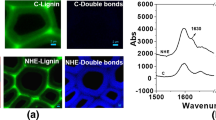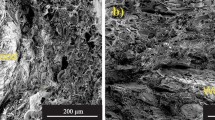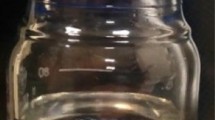Abstract
Synthetic wood composite films containing cellulose, hemicelluloses, and lignin, the three major components of natural wood, were prepared in a room temperature ionic liquid solvent, 1-ethyl-3-methylimidazolium acetate, [EMIM][Ac]. Various synthetic wood composites were obtained by dissolution of individual wood components together with additives, including polyethylene glycol (PEG), chitosan, and multi-wall carbon nanotubes (MWNTs) in [EMIM][Ac]. The addition of water affords a gel that was dried in either a low humidity environment or under vacuum. Synthetic wood films showed smoother surface textures, higher water resistance, and higher tensile strengths than cellulose films formed by the same methods. Tailor-made synthetic wood composites were also prepared having a variety of desirable properties, including antimicrobial activities, controlled hydro-phobicity/philicity, high relative dielectric constant, and a high degree of cohesiveness.








Similar content being viewed by others
References
Aaltonen O, Jauhiainen O (2009) The preparation of lignocellulosic aerogels from ionic liquid solutions. Carbohydr Polym 75:125–129
Bartkowiak M, Zakrzewski R (2004) Thermal degradation of lignins isolated from wood. J Therm Anal Calorim 77:295–304
Brown RM (2004) Cellulose structure and biosynthesis: what is in store for the 21st century? J Polym Sci Part A Polym Chem 42:487–495
Chandra RP, Bura R, Mabee WE, Berlin A, Pan B, Saddler JN (2007) Biofuels book series. Adv Biochem Eng Biotechnol 108:67–93
Chanzy H, Peguy A, Chaunis S, Monzie P (2003) Oriented cellulose films and fibers from a mesophase system. J Polym Sci Polym Phys 18:1137–1144
Chiappe C, Pieraccini D (2005) Ionic liquids: solvent properties and organic reactivity. Phys Org Chem 18:275–297
Davé V, Glasser WG (1997) Cellulose-based fibres from liquid crystalline solutions: 5. Processing and morphology of CAB blends with lignin. Polymer 38:2121–2126
Dizhbite T, Telysheva G, Jurkjane V, Viesturs U (2004) Characterization of the radical scavenging activity of lignins—natural antioxidants. Bioresour Technol 95:309–317
El Seoud OA, Koschella A, Fidale LC, Dorn S, Heinze T (2007) Influence of the supramolecular structure and physicochemical properties of cellulose on its dissolution in a lithium chloride/N, N-Dimethylacetamide solvent system. Biomacromolecules 8:2629–2647
Fort DA, Remsing RC, Swatloski RP, Moyna P, Moyna G, Rogers RD (2007) Can ionic liquids dissolve wood? Processing and analysis of lignocellulosic materials with 1-n-butyl-3-methylimidazolium chloride. Green Chem 9:63–69
Fukaya Y, Sugimoto A, Ohno H (2006) Superior solubility of polysaccharides in low viscosity, polar, and halogen-free 1, 3-dialkylimidazolium formats. Biomacromolecules 7:3295–3297
Gabrielii I, Gatenholm P (1998) Preparation and properties of hydrogels based on hemicelluloses. Appl Polym Sci 69:1661–1667
Goksu EI, Karamanlioglu H, Bakir U, Yilma L, Yilmazer U (2007) Production and characterization of films from cotton stalk xylan. Agric Food Chem 55:10685–10691
Himmel ME, Ding S-Y, Johnson DK, Andey WS, Nimlos MR, Brady JW, Foust TD (2007) Biomass recalcitrance: engineering plants and enzymes for biofuels production. Science 315:804–807
Kilpeläinen I, Xie H, King A, Granstrom M, Heikkinen S, Agrgyropoulos DS (2007) Dissolution of wood in ionic liquids. Agric Food Chem 55:9142–9148
Kosan B, Michels C, Meister F (2008) Dissolution and forming of cellulose with ionic liquids. Cellulose 15:59–66
Lee SH, Doherty TV, Linhardt RJ, Dordick JS (2009) Ionic liquid-mediated selective extraction of lignin from wood leading to enhanced enzymatic cellulose hydrolysis. Biotechnol Bioeng 102:1368–1376
Lee SH, Miyauchi M, Dordick JS, Linhardt RJ (2010) Preparation of biopolymer-based materials using ionic liquids for the biomedical applications. In: ACS symposium series ionic liquids application: pharmaceutical, therapeutics, and biotechnology 1038:115–134
Li C, Wang Q, Zhao ZK (2008) Acid in ionic liquid: an efficient system for hydrolysis of lignocelluloses. Green Chem 10:177–182
Möller H, Grelier S, Pardon P, Coma V (2004) Antimicrobial and physicochemical properties of chitosan–HPMC-based films. J Agric Food Chem 52:6585–6591
Novoselov NP, Sashina ES, Kuz’mina OG, Troshenkova SV (2007) Ionic liquids and their use for the dissolution of natural polymers. J Gen Chem 77:1395–1405
Pushparaj VL, Manikoth SM, Kumar A, Murugesan S, Ci L, Vajtai R, Linhardt RJ, Nalamasu O, Ajayan PM (2007) Flexible nanocomposite thin film energy storage devices. Proc Natl Acad Sci 104:13574–13577
Saha BC (2003) Hemicellulose bioconversion. Ind Microbiol Biotechnol 30:279–291
Sheldon RA, Lau RM, Sorgedrager MJ, van Rantwijk F (2002) Biocatalysis in ionic liquids. Green Chem 4:147–151
Šimkovic I (2008) What could be greener than composites made from polysaccharides? Carbohydr Polym 74:759–762
Sun N, Rahman M, Qin Y, Maxim ML, Rodríguez H, Rogers RD (2009) Complete dissolution and partial delignification of wood in the ionic liquid 1-ethyl-3-methylimidazolium acetate. Green Chem 11:646–655
Swatloski RP, Spear SK, Holbrey JD, Rogers RD (2002) Hemicellulose bioconversion. J Am Chem Soc 124:4974–4975
Tharanathan RN (2003) Biodegradable films and composite coatings: past, present and future. Trends Food Sci Technol 14:71–78
Welton T (1999) Room-temperature ionic liquids. Solvents for synthesis and catalysis. Chem Rev 99:2071–2084
Wu RL, Wang XL, Li F, Li HZ, Wang YZ (2009) Green composite films prepared from cellulose, starch and lignin in room-temperature ionic liquid. Bioresour Technol 100:2569–2574
Yang C, Lin Y, Nan CW (2009) Modified carbon nanotube composites with high dielectric constant, low dielectric loss and large energy density. Carbon 47:1096–1101
Zhao H, Baker BA, Song ZY, Olubajo O, Crittle T, Peters D (2008) Designing enzyme-compatible ionic liquids that can dissolve carbohydrates. Green Chem 10:696–705
Zhao Q, Yam RCM, Zhang B, Yang Y, Cheng X, Li RKY (2009a) Novel all-cellulose ecocomposites prepared in ionic liquids. Cellulose 16:217–226
Zhao X, Koos AA, Chu BTT, Johnston C, Grobert N, Grant PS (2009b) Spray deposited fluoropolymer/multi-walled carbon nanotube composite films with high dielectric permittivity at low percolation threshold. Carbon 47:561–569
Acknowledgments
The authors would like to thank Fangxiao Guan from the University of Connecticut for assistance in measurement of dielectrical properties. The authors would also like to thank Dr. Tom Doherty and Dr. Hong Wu for helpful discussion and HPLC measurement of hydrolyzed synthetic wood film. The authors acknowledge the support of Chisso Corporation and the Rensselaer Nanotechnology Center for their partial funding of this research.
Author information
Authors and Affiliations
Corresponding author
Electronic supplementary material
Below is the link to the electronic supplementary material.
226_2010_395_MOESM1_ESM.doc
HPLC results for standard glucose, xylose, and hydrolyzed synthetic wood film. UV–Vis for lignin content in acidic aqueous solution (DOC 44 kb)
Rights and permissions
About this article
Cite this article
Simmons, T.J., Lee, S.H., Miao, J. et al. Preparation of synthetic wood composites using ionic liquids. Wood Sci Technol 45, 719–733 (2011). https://doi.org/10.1007/s00226-010-0395-6
Received:
Published:
Issue Date:
DOI: https://doi.org/10.1007/s00226-010-0395-6




